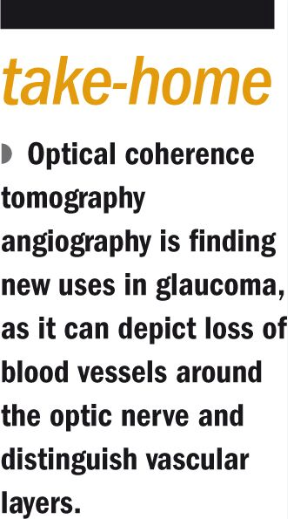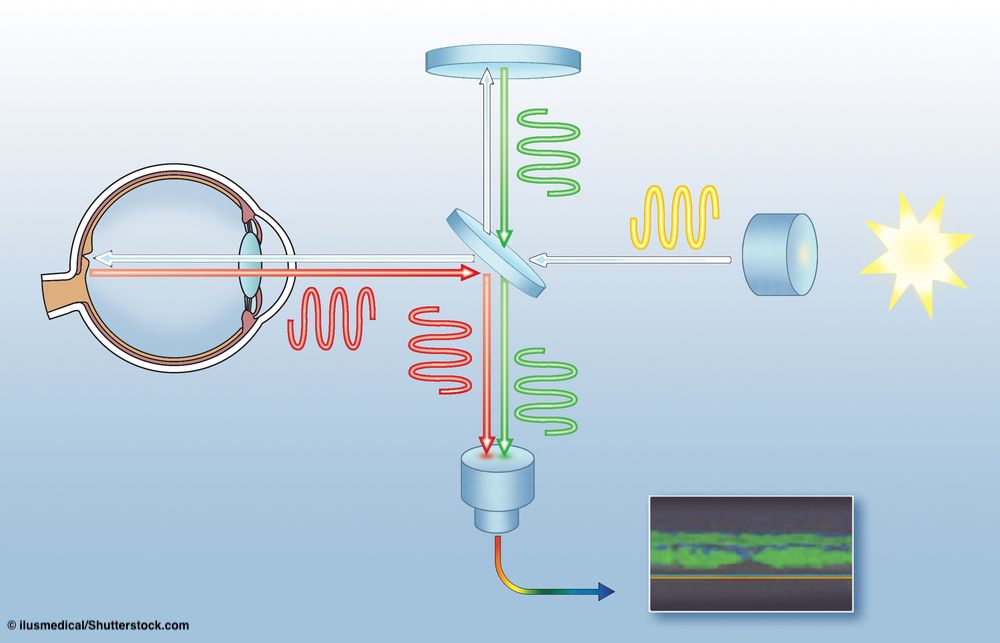Article
Angiography boosts OCT in glaucoma
Author(s):
Optical coherence tomography angiography is finding new uses in glaucoma, as it can depict loss of blood vessels around the optic nerve and distinguish vascular layers.


Reviewed by Robert Stamper, MD
Optical coherence tomography (OCT) angiography could yield important insights into glaucoma, according to Robert Stamper, MD.
The new imaging technique shows significant loss of blood vessels around the optic nerve in patients with glaucoma, said Dr. Stamper, professor of ophthalmology, University of California, San Francisco.
OCT tomography scanners can create about 70,000 images of the back of the eye in 3 seconds. Using artificial intelligence, they apply corrections for blinking and microsaccades, said Dr. Stamper.
“If you have a constant background-the retina-and something is moving across it, and you know how quickly you’ve taken the photos, and the distance, you can sort out the movement that’s occurred from the stable background,” he explained. “That’s basically what OCT angiography depends upon.”
This analysis produces pictures of blood vessels-capillaries, as well as the arterioles and venules in the retina. Its in-depth scans can distinguish vascular layers.
“Motion correction is applied to get rid of saccades, so you get very nice pictures of both the capillary density and sometimes the structure of the capillaries,” said Dr. Stamper.
The pictures produced resemble a flat preparation of the whole retina. For that reason, retina specialists have been the first ophthalmologists to begin using the new technology. They are using it to analyze macular degeneration.
“I don’t think you need to be an expert to pick up holes,” Dr. Stamper said.
Vascular anomalies show up in OCT angiography of eyes with diabetic retinopathy as well, he said.
In glaucoma, researchers are using the new tool to look more closely at the macula, nerve areas, and peripapillary areas. Comparing an image of a normal eye to an image of a glaucomatous eye, Dr. Stamper showed the absence of the capillary bed in the inferotemporal region. The loss of capillaries coincided with the area where the nerve fiber had degenerated, he pointed out.
“The big question is, ‘Does the capillary loss precede the nerve fiber layer loss, or does the nerve fiber layer loss precede the loss of capillary?’ I don’t have an answer to that.”
In another glaucoma image, he showed that the peripapillary region was reduced in its density. OCT angiography showing radial peripapillary capillaries lost at the level of the nerve confirm similar findings from a study on hundreds of specimens from eye banks conducted about 35 years ago, Dr. Stamper said. “Just as the axons go into the optic nerve, that layer is reduced in glaucoma,” he said. “It’s not new information, it’s been around for a long time.”
Particularly in the superficial circulation around the optic nerve, there is a decrease in the capillary density, he pointed out. “The deep layers don’t seem to be affected.”
The newer versions of OCT angiography software use color to compare the capillary density, distinguishing between areas where the capillaries are merely reduced and areas where they are completely missing.
“We actually can get numbers, so we can start to quantify,” Dr. Stamper said. “It’s a very, very interesting new technology.”
Already studies with OCT angiography have shown that the repeatability of vascular density measurements is reasonable.
“The pictures you would get are similar to indocyanine green angiography, but of course this is completely noninvasive.”
The technology can even capture changes that come with early ocular hypertension, he said.
Another important finding: reducing IOP with a successful trabeculectomy does not bring back the vascular supply. “It looks like once the vessels go, they stay gone. So that’s a little bit disturbing.”
The new images correlate well with regular OCT and visual fields.
“The question is, are we going to learn anything new that we don’t already know from this technology?” he said.
Hoping for an answer in the affirmative, researchers are starting to use quantitative measures and trends over time to search for clues about the pathophysiology of glaucoma. Among the questions this approach might help answer:
- Does the loss of circulation occur gradually or episodically?
- How well does the macular capillary density compare to the peripapillary capillary density?
- Are there some patients in whom the vascular capillary density goes first, and then the nerve fiber layer seems to atrophy? In those particular patients, will it tell clinicians to focus more on the vascular issues?
Such studies could lead to individualization of glaucoma understanding and treatments, he said.
“We don’t have answers to those questions, and we certainly don’t even know if OCT angiography gives us additional information over and above the standard OCT,” said Dr. Stamper.
“But we think it’s a fascinating technology. And I have a feeling in my gut-backed up by no science whatsoever, so therefore I can speak with great passion about it-that it will offer us some insight.”
Disclosures:
Robert Stamper, MDP: 415/514–6920
This article was adapted from Dr. Stamper’s presentation at the 2018 meeting of Glaucoma 360. He did not indicate any proprietary interest in the subject matter.
Newsletter
Don’t miss out—get Ophthalmology Times updates on the latest clinical advancements and expert interviews, straight to your inbox.




